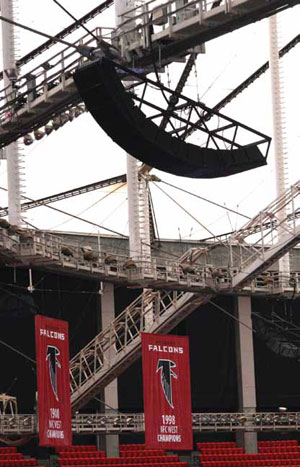Top Sound

The Georgia Dome Rounds Out its Renovation with an Audio System Overhaul
ATLANTA, GA—The Georgia Dome, home to the Atlanta Falcons football team, has undergone a $55 million building renovation over the past four years, including a recently completed audio system renovation. Atlanta’s Comprehensive Technical Group (CTG) worked with Phoenix Engineering and Atlanta Rigging Systems to install the new all-Harman sound system at the facility, which is the world’s largest cable-supported domed stadium.
Audio technology has made some advances since the Georgia Dome was originally built in 1992. With pre-produced playback material the norm at many events these days, the previous sound system simply did not offer the fidelity for the task.
“It was done in a very old-school manner and was well past its life expectancy,” said Josh Shibler, CTG’s project manager. The clusters of older, horn-loaded speaker cabinets were removed and replaced by a system that includes new JBL speakers and Crown amplifiers.
Part of the challenge with this installation was the venue’s very busy events calendar, according to Shibler. “There were 10 new line arrays that replaced the 22 that came down. It was a big logistics game; changing 144 amplifiers, rewiring 11 equipment racks, and flying 140 speakers in two weeks, as well as removing the existing infrastructure, was a bit of a feat.
“We grabbed the largest contiguous block [of available days] and made sure we had everybody lined up,” he continued. “At one point we were running a crew of 28 to try and condense things into a two-week period and get through the major changeover.”
The primary main array setup serves the needs of the NFL season for the Falcons. A JBL VerTec system covers the entire arena, which accommodates just over 71,000 people. Phoenix Engineering and Atlanta Rigging Systems provided specialized expertise, respectively fabricating custom steel cradles for each array, which each comprise 10 to 12 cabinets and weight up to 3,500 pounds, and suspending and positioning each array approximately 150 feet above the field.
A daily selection of the top stories for AV integrators, resellers and consultants. Sign up below.
CTG installed 71 Crown I-T5000HD, 62 I-T9000HD, and two CTS-3000 amplifiers. The entire sound system is networked via a BSS BLU -800 and two BLU -120 processors and under the control of Harman’s HiQnet System Architect.

A JBL VerTec system covers the entire arena, which accommodates just over 71,000 people.
The Georgia Dome, which has been the venue for two Super Bowls, XX VIII and XXXI V, has also hosted Men’s and Women’s NCAA Final Four basketball tournaments as well as regional semi- and finals basketball games. Olympics sporting events, wrestling, soccer, bull riding, robotics competitions, and religious conferences have all found their way onto the Dome’s calendar over the years.
For basketball games, and any other appropriate events, there is a second sound system, reported Shibler. “There’s an alternate configuration that utilizes JBL products to build a center-hung basketball configuration. They do a converted mode where they hang a curtain halfway across the Dome and set it up for the NCAA Men’s Final Four. They bought a secondary system with a set of powered cabinets that hang from a center configuration for those events.”
The sound system for basketball games includes 30 VT4887 threeway compact line array elements, six VT4881 arrayable subwoofers, plus 34 PD5212/95 and six PD5212/43 loudspeakers.
CTG had previously rebuilt the video infrastructure and control room at the Dome, integrating new HD video displays measuring 101 feet wide by 24 feet high, supplied by CBS Outdoors, that were installed in both end zones. According to Ry Alford, senior account manager, CTG, “One of the things that helped us win the competition for the audio was the good job that they’d seen us do with the video system. They knew we could handle the logistics of the audio job. We could handle the technical side; we had the experts on-staff. And it’s always nice to work with people you know.”
Steve Harvey (psnpost@nbmedia.com) has been west coast editor for Pro Sound News since 2000 and also contributes to TV Technology and Pro Audio Review. He has 30 years of hands-on experience with a wide range of audio production technologies.
